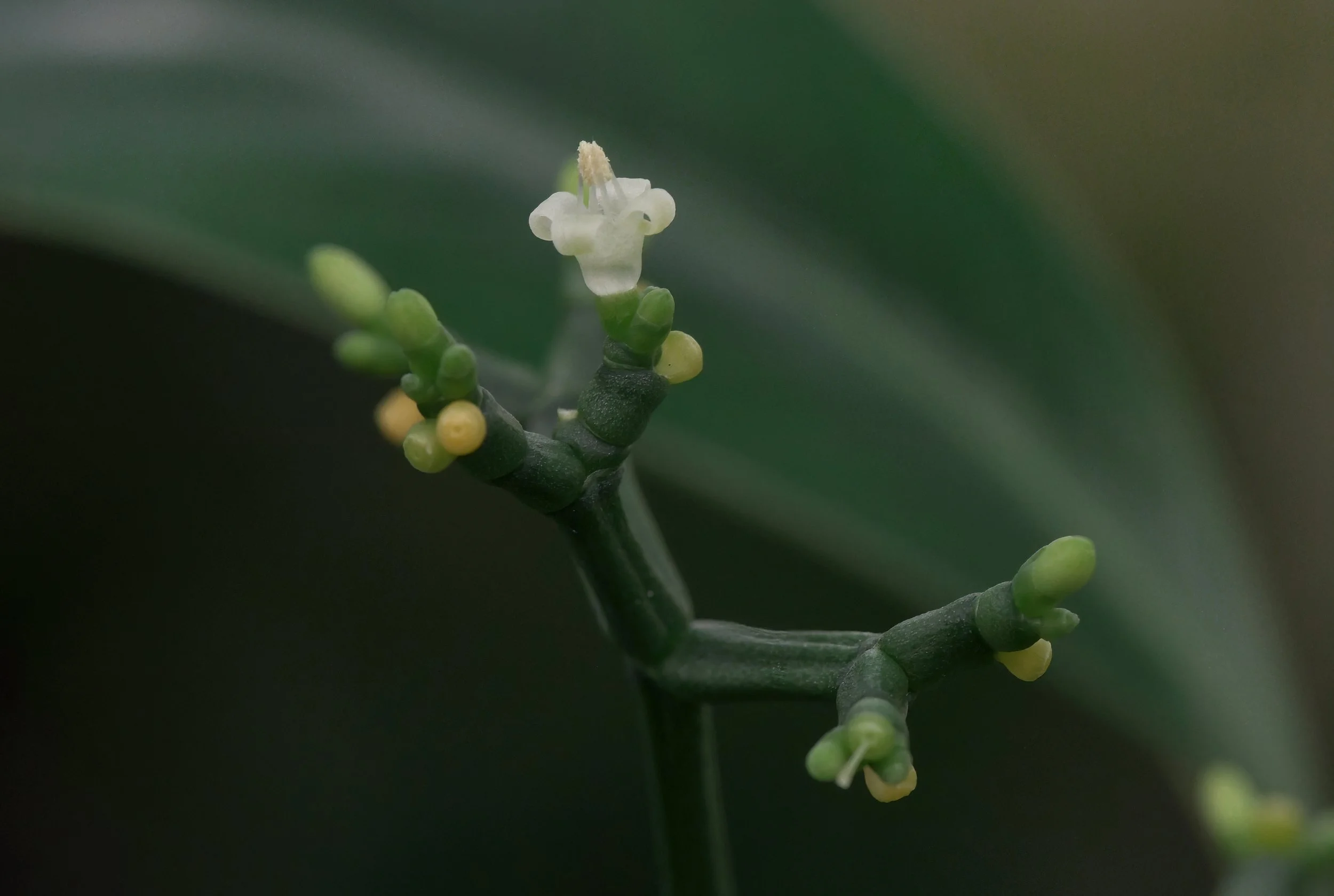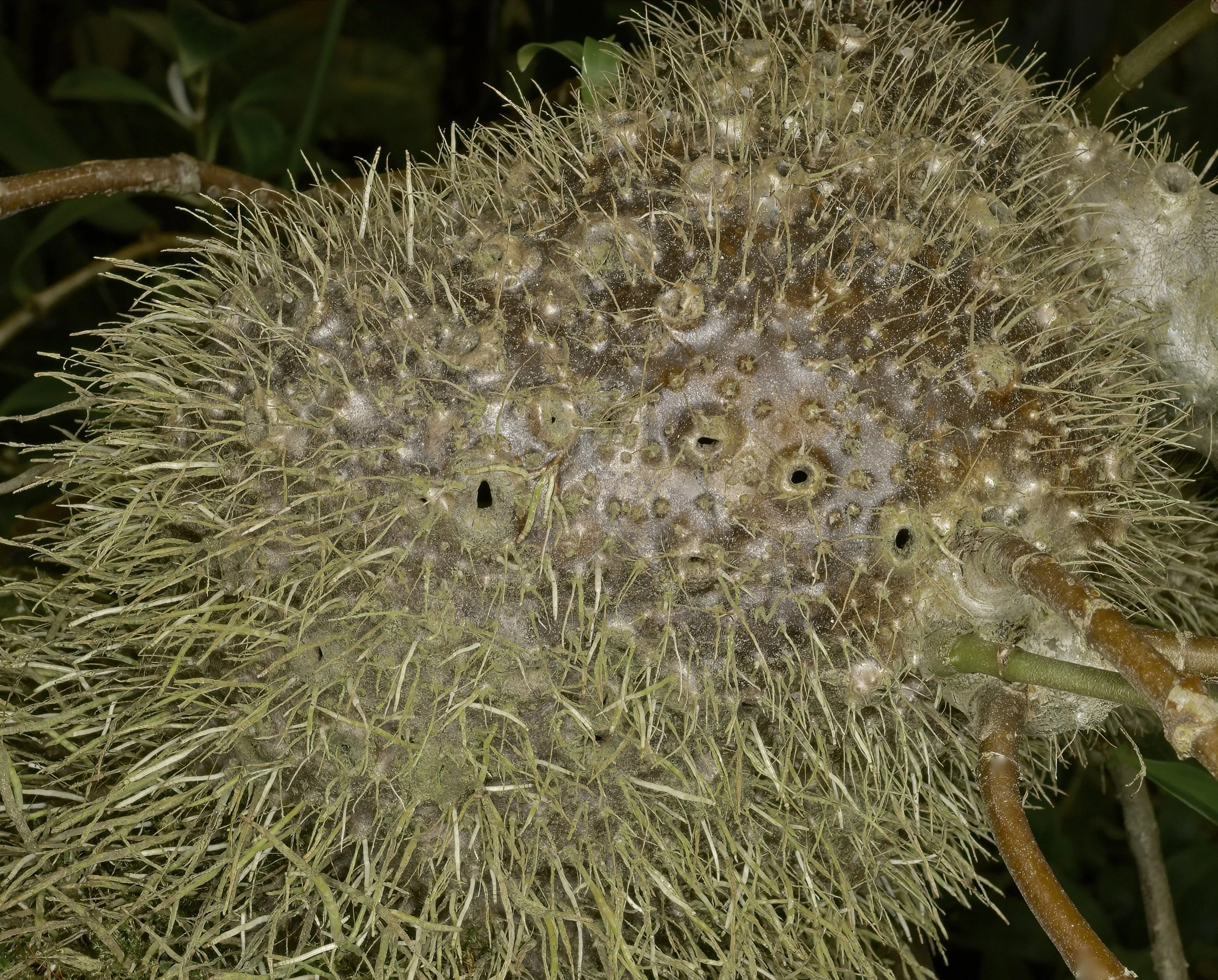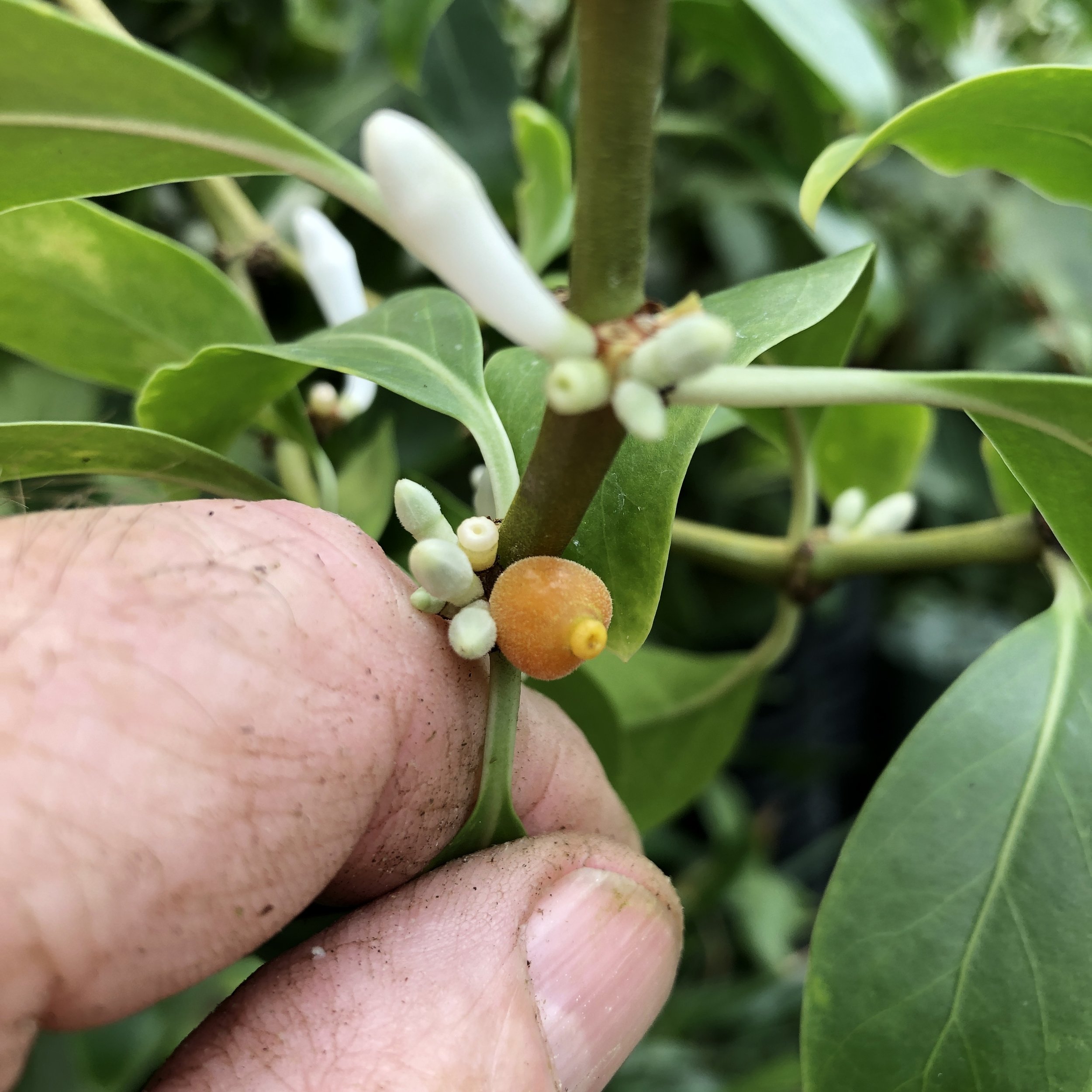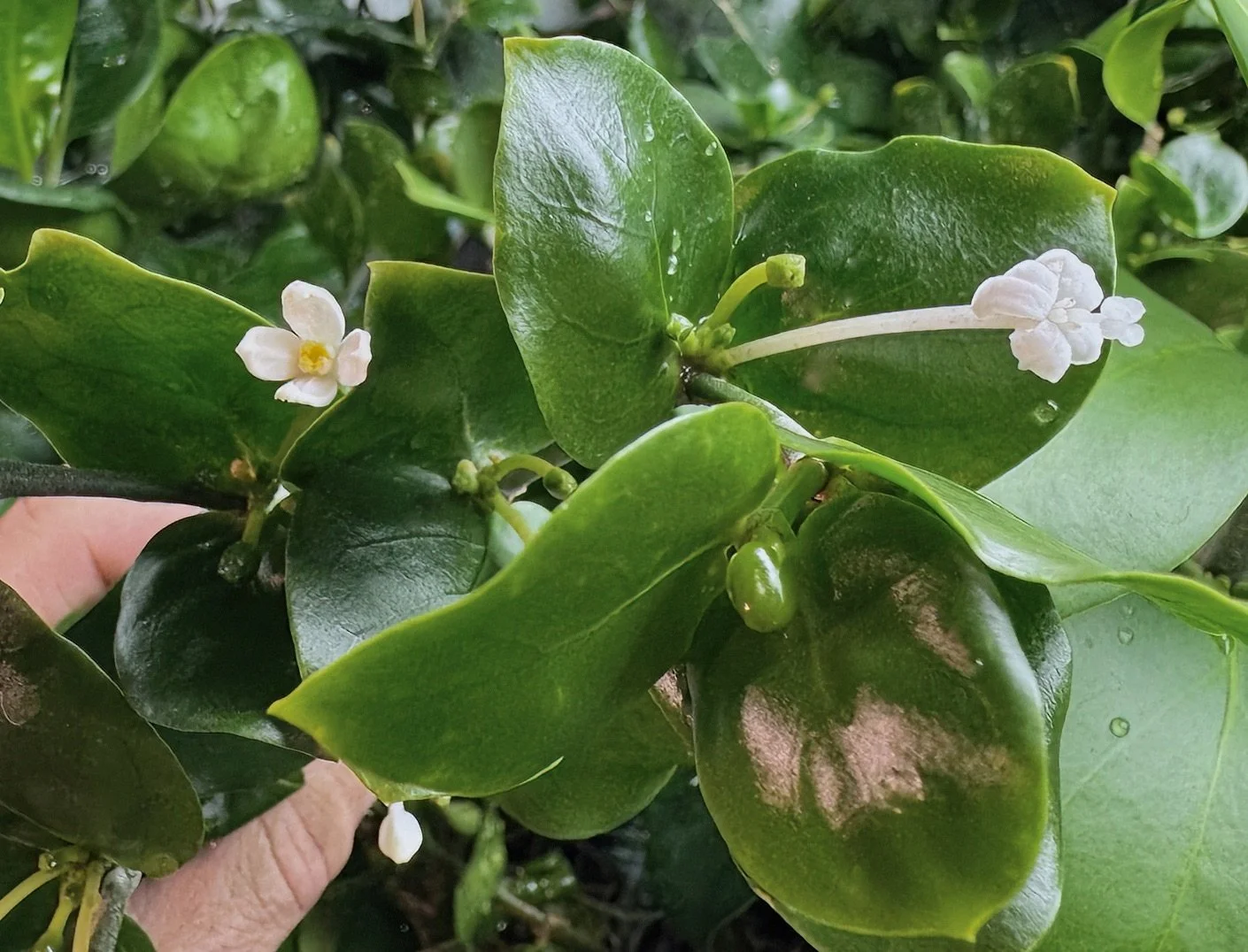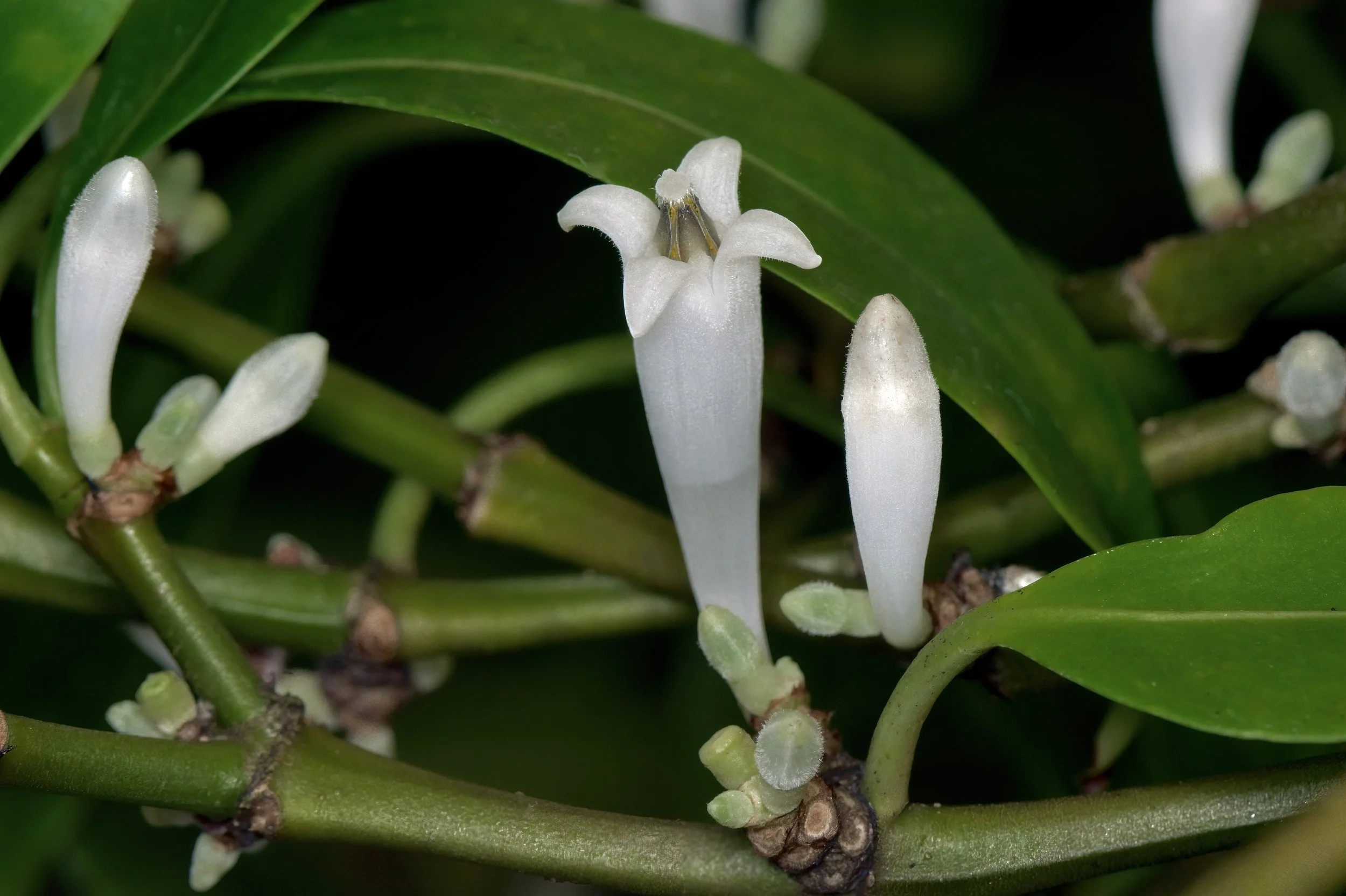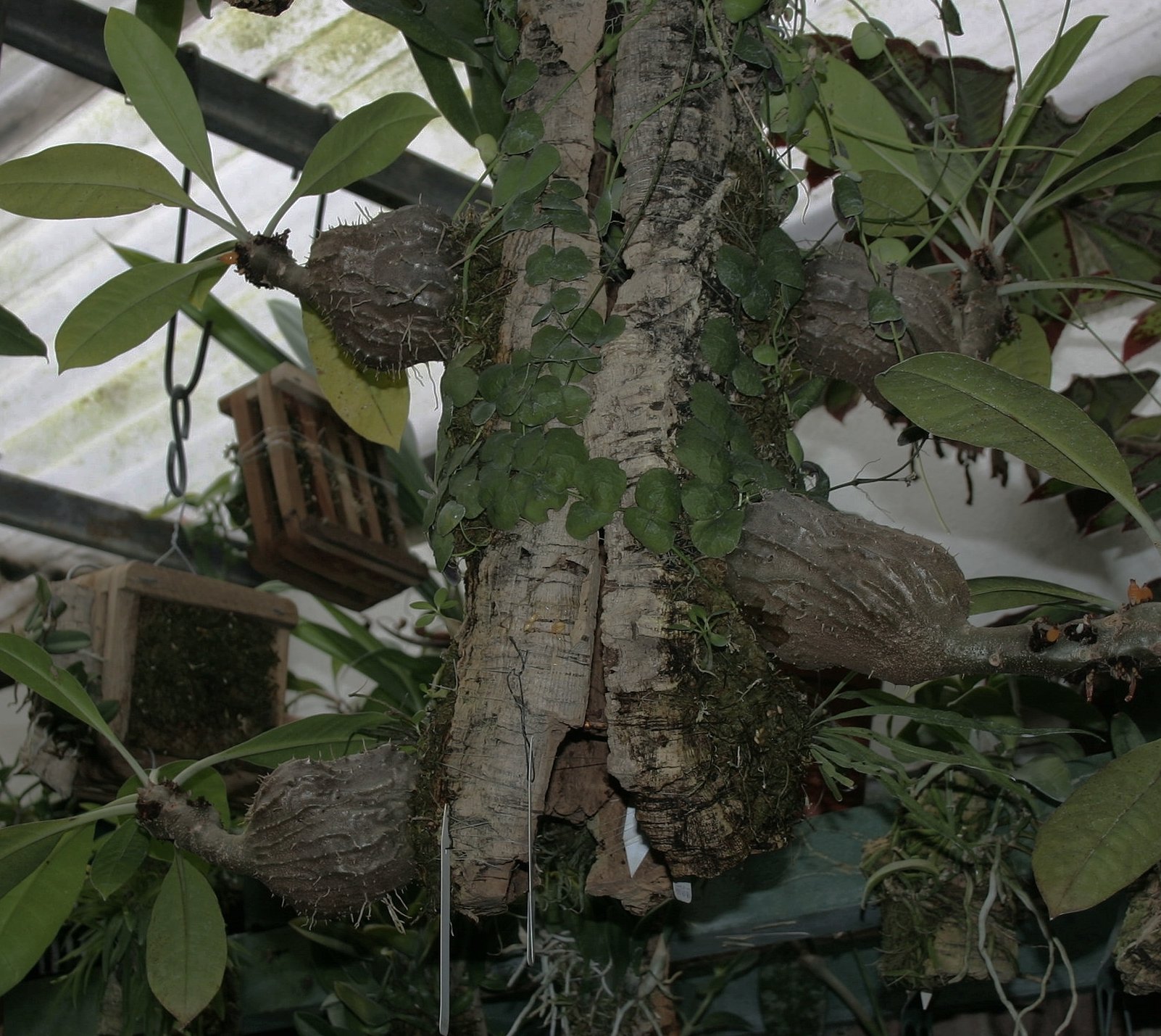Squamellarias: The Natural History & Cultivation of Fijian Tree Testicles
Tips for Growing Hairy Balls
By Jay Vannini
Caudex detail on a young mature, second-generation, seed grown Squamellaria major cultivated in the author's collection in California. Tuber diameter exclusive of the the medusoid adventitious roots is 9"/23 cm and overall plant span across branches exceeds 30"/75 cm. Original accession likely from the lower slopes of Des Voeux Peak-Mount Manuka, Taveuni Island, Fiji. Image: ©Jay Vannini 2024.
Over the past two decades, a surprisingly large number of new and noteworthy plant species have sneaked into ornamental horticulture from remote regions in the tropics. The trophies that immediately come to mind include many rare orchids, begonias, palms, aroids, pitcher plants, and gesneriads. Those aside, other notables fall into the broad category known as “stem succulents”. While most of these succulent novelties originate from arid environments in Africa and the New World, some of the strangest of all were discovered in the faraway cloud- and rainforest canopies of Malesia and Papuasia.
Old World caudexed ant plants (Rubiaceae: Psychotriaeae, Hydnophytinae) currently include five genera of specialized, mostly epiphytic and myrmecophytic (= ant-associated) tropical plants that range from the southern Asian mainland throughout Malesia to as far south as northeastern Australia and the Fijian Islands (Jebb & Huxley, 2019). The island of New Guinea is the center of diversity for the subtribe, with four of the five currently recognized genera occurring there and another on an offshore autonomous territory to its east. The number of recently described species and images of obvious novelties posted online suggests at least two genera (i.e., Myrmecodia and Hydnophytum) are likely significantly under-described (Jebb & Huxley, 2019; pers. obs.).
One of the least known and perhaps most interesting of all hydnophytine genera to tropical succulent plant collectors is Squamellaria Becc.
A cultivated Squamellaria huxleyana in an 8"/20 cm hydro basket. Caudex diameter 6"/15 cm. Original accession likely from the road to Labasa, Vanua Levu Island, Fiji. Author's collection. Image: ©Jay Vannini 2024.
The Genus
A mature Hydnophytum mamberamoense growing in my collection in California showing multiple growth points and developing stems from the base of the primary caudex. Overall plant span >48"/130 cm. An unusual-looking hydnophytine from north Papua, Indonesia, H. mamberamoense shares plant and floral characters with three genera but seems a bad match for any single existing one. Image: ©Jay Vannini 2024.
Squamellaria was originally diagnosed by famed 19th century Italian naturalist Odoardo Beccari who differentiated it from Hydnophytum by the presence of a group of fringed scales or squamellae along the inner edges of their corolla petals. This morphological character is now known to be absent in some members of the genus (Chomicki & Jenner, 2016a). Based on the incomplete dried collections he examined that lacked stem sections, Beccari was unsure whether his new genus was caudiciform. A later work (Jebb, 1991) highlighted other unique features that include semi-discrete cavity structures (domatia) with stems arising from multiple points along on the caudexes, not just on the tuber apex, as was then believed to be the case for other hydnophytines known at that time. This is now recognized to not be the case, since at least three Papuan Myrmecodia species, together with other relatively recent finds such as Hydnophytum caminiferum Wistuba, U. Zimm., Gronem. & Marwinski and H. mamberamoense Jebb & C. R. Huxley can also develop multiple fattened stems at different locations along their caudexes and at the bases of major roots (see image right; pers. obs.).
Notwithstanding these similarities, Fijian Squamellaria species are instantly recognizable to botanists and collectors due to a unique and conspicuous combination of plant characters that readily differentiate them from other hydnophytines.
Conversely, the three small-flowered Solomon Island and Vanuatu species presently included in the genus Squamellaria branch only from the apices of their caudexes and do not develop petioles and leaves from elsewhere on their tubers.
Above left, a Squamellaria kajewskii “female”/longistyle flower. Original accession grown from seed collected on the road to the Pangua Mine, Crown Prince Range, Autonomous Region of Bougainville, Papua New Guinea. Right, a Squamellaria guppyana “male”/brevistyle flower. Original accession grown from seed collected at Kobuan Village, Kieta, Autonomous Region of Bougainville, Papua New Guinea. Specialists have noted the superficial similarity of the multi-branched inflorescences of the Solomon Island Squamellaria guppyana to some well-known tropical Psychotria species, e.g., chacruna, (P. viridis). The flowers, caudexes, and plant forms of Papua New Guinea and Vanuatu Squamellaria species are conspicuously dissimilar to the Fijian members of the genus, and they likely deserve a carve-out into their own. Both plants grown in the author’s collection. Images: ©Jay Vannini 2024.
A look-down at the foliage of another mature Squamellaria major cultivated in the author's collection. Large, subcoriaceous leaves with conspicuously elevated leaf veins and undulate margins are diagnostic for the species. The flowers of S. major are colorful for a caudiciform ant plant. Image: ©Jay Vannini 2024.
Botanist Matthew Jebb’s 1991 treatment of the genus recognized three valid Squamellaria species, including one discovered by Asa Gray in 1840 and described by Beccari in 1886; one discovered and described by Albert Charles Smith in 1967; and one discovered by Jebb himself in 1983 and described in his later monograph on the genus.
Following Jebb’s publication, seemingly little attention was paid to the genus outside of occasional observations made by foreign botanists working in Fiji.
This changed suddenly when amateur succulent specialist Derrick Rowe visited the islands in August 2013 and published images of these remarkable plants in nature on his social media pages and elsewhere on the internet. Derrick’s findings sparked a great deal of interest among myrmecophyte collectors in the EU and USA. His trip was followed by the first visits to Fiji made by Andreas Wistuba and Guillaume Chomicki in 2014. Fieldwork at that time by both botanists revealed that, besides three previously recognized species (Jebb, 1991), there were several other undescribed Squamellaria taxa inhabiting both the Fiji Islands and several islands in Vanuatu well to the west (Chomicki & Renner, 2016a).
The are eight valid species recognized at this time, five of which occur in Fiji and are shown in highlights: Squamellaria grayi Chomicki & Wistuba, S. guppyana (Becc.) Chomicki, S. huxleyana Chomicki, S. imberbis (A. Gray) Becc., S. kajewskii (L. M. Perry) Chomicki, S. major A. C. Smith, S. thekii Jebb, and S. vanuatuensis Jebb & C. R. Huxley ex Chomicki & S. S. Renner (Jebb & Huxley, 2019; POWO, 2024). Given the 2014 discoveries, it would not be surprising if further fieldwork in Fiji reveals other overlooked novelties.
Please refer to the Jebb & Huxley Hydnophytum revision (2019) for a trio of Squamellaria species (S. jebbiana Chomicki, S. tenuiflora [Becc.] Chomicki, and S. wilkinsoniana [Horne ex-Baker] Chomicki) sunk into synonymy with H. grandiflorum Becc. and H. longiflorum A. Gray by them in 2019 (POWO, 2024).
“...the specific epithet thekii was derived from the Fijian name theke theke nkau that is used for native tuber forming ant plants on the islands, meaning “testicles of trees”
An excellent image of a flowering Squamellaria wilsonii (= S. imberbis) taken in nature on Taveuni Island, Fiji. The taxonomic status of S. wilsonii (Horne ex Baker) Becc. remains somewhat unsettled. It has been sunk into synonymy with S. imberbis in two separate instances by one authority of the genus and resurrected twice by another. Currently (2024), the Royal Botanical Garden Kew's POWO treats it as a synonym of S. imberbis. Despite this, S. wilsonii lingers as a name in the live plant trade. Image: ©John Game 2018. Licensed for non-commercial use by Creative Commons, CC BY 2.0.
Fijian Squamellarias entered international commerce as first generation, captive propagated, seed-grown plants in limited numbers in the mid-2010s. At this time, all of the described species in the genus from throughout its range are available in cultivation as juvenile specimens of multi-generational, artificially-propagated stock in the EU, USA, and Japan.
Hairy Balls?
The caudexes of Fijian Squamellaria species are usually ovoid or subglobular, dark colored, and covered throughout with adventitious roots, giving the mature tubers a distinctly bristly or hairy look. They have been observed both as trunk and branch epiphytes in native habitat, where they seem conspicuous elements in the canopy. They sometimes occur in dense “farmed” colonies (see image of mixed S. major and S. thekii plants in Chomicki & Renner, 2016a)
Their appearance both in nature and cultivation is definitely thought-provoking.
Caudex detail of an artificially propagated Squamellaria huxleyana grown under bright conditions (900 fc/9,700 lumens sq. m) in a temperature and humidity controlled tropical greenhouse. Light physiological stress imposed on these plants in cultivation promotes the development of natural-looking plant forms. Author's collection. Image: ©Jay Vannini 2024.
In his description of Squamellaria thekii Matthew Jebb noted that the specific epithet thekii derives from the Fijian name theke theke nkau. It is the local name for tuber-forming epiphytic ant plants that inhabit the islands, and means “testicles of trees” (Jebb, 1991; Eggli & Newton, 2004).
At least two contemporary Fijian-English dictionaries mention that in Fijian a C is pronounced as is a soft TH sound is in English; this substitution appears in other spellings. Ceke has also been translated as, “enlarged testicles from elephantiasis” (Gatty, 2009; 2012). Ni indicates of or for, and kau means tree, shrub, wood, or plant, so ceke ni kau (= Jebb’s [1991] and Chomicki & Renner’s [2016a] theke theke nkau) has been proposed as an optional phrase (Forum for Epiphytic Myrmecophytes, 2023).
Bristly root spines on a mature, multigenerational seed grown Squamellaria imberbis grown under light shade but in a well ventilated, humid spot in the greenhouse. Original accession from an undisclosed locality on Vanua Levu Island, Fiji. Image: ©Jay Vannini 2024.
Chomicki & Renner also added theketuwawa (= giant scrotum) together with mokamoka (derived from moqimoqli? = round or spherical) and ndatokaikai – as terms of unknown meaning – to the list of local names for hydnophytines. Ronald Gatty includes tatuku and matuko in his Fijian-English dictionary as other words describing the effects of elephantiasis of the scrotum.
Ouch.
Elephantiasis of the scrotum he said? Tuber detail of a young mature Squamellaria sp. cf. thekii growing in the author's collection and cultivated under "soft", shady conditions. Original accession likely from the lower slopes of Des Voeux Peak, Taveuni Island, Fiji. This species was described from a unicate in 1991 and remains one of the least understood and photographed Squamellaria species. The clustered stem development shown here is diagnostic for the species. At least one photo posted online, ostensibly of this species in nature, shows a mature S. major instead. A note under an image included in Chomicki et al. (2019) indicates that S. thekii may be found growing with S. major on the same limb. Presumably, this syntopy can lead to confusion when viewed from afar. Image: ©Jay Vannini 2024.
Plant Farming or Farming Ants?
Leaf-cutting ants, Atta sexdens (Linnaeus) returning to their nest after foraging. New World Attine ants are the earliest known lineage to develop ant-plant agricultural relationships. Quistococha, Loreto Department, Perú. Image: ©William W. Lamar.
Ant agricultural practices are among some of the most interesting symbiotic associations between animals and plants. Subsistence farming of fungi by leafcutter/fungus-growing ants (Formicidae: Myrmicinae, Attinii) in the American tropics is believed to have evolved between 55 and 60 to million years ago (Mya), with increased specialization by these ants increasing protein yields from their subterranean plots ~25 Mya (King & Lavery, 2016; Nygaard et al., 2016). Leaf cutters are the oldest lineage and best known ant “agriculturists”, but one Fijian ant has taken plant farming to an even more advanced symbiosis, evolving into highly specialized and accomplished horticulturalists in only ~three million years (Chomicki & Renner, 2016a; Chomicki et al., 2019).
Philidris nagasau (Mann) (Formicidae: Dolichoderinae, Leptomyrmecinii), is an arboreal ant species endemic to the islands of Taveuni and Vanua Levu in Fiji. The highly defensive insect is considered a polydomous form of ant in that they may move across more than one colony, which may include as many as dozens of individual Squamellaria plants. In Fiji, there are also records of a wide-ranging ant, Camponotus chloroticus (Formicinae, Camponotini), inhabiting Hydnophytum caudexes. Other Philidris (formerly placed in Iridomyrmex), Camponotus and Crematogaster (Myrmicinae, Crematogastrini) species are associated with lowland hydnophytines and Dischidia (Apocynaceae) on the East Asian mainland, Malesia, New Guinea, and Australia (Weissflog et al., 2017).
The relationship between Philidris nagasau and native Squamellaria varieties is unique in that the ant actively propagates the plants by harvesting seed from partially ripe fruits, then “direct seeds” the individual drupes into bark crevices. Small groups of ants remain at the sowed plot, reportedly to protect the seeds and seedlings during early development. What is remarkable about this particular relationship in a non-human animal is that actively cultivated plants actually do provide both food and shelter to their farmers. The ants derive nutritive benefits from the plants in the form of nectar rewards offered by their flowers, and find housing for their colonies within their wards’ domatia.
Following Chomicki and co-researchers’ findings, Campbell et al. (2023) proposed the Fijian agricultural model as one of three primary types of systems adopted by mutualistic ants, in this case an apparently obligate relationship in nature.
Seedling Squamellaria major sown in a bark mix filling the hanging basket of the mother plant whose velamentous roots are shown throughout. Author's collection. Image: ©Jay Vannini 2024.
In Cultivation
As is the case for other tropical plant taxa with highly evolved myrmecophytic relationships in nature, ants are – fortunately – not required for successful cultivation of Squamellaria species.
Like many hydnophytines, when grown properly the Fijian Squamellaria species can attain substantial size in fairly short order. Despite their mature caudexes being of relatively modest dimensions when compared to the giant members of Anthorrhiza, Hydnophytum, and Myrmecodia (i.e., mostly <20”/<50 cm in diameter as compared to >30”/>75 cm), the partially woody petioles are arranged in a radial form and are long-spreading in all. The foliage of Fijian Squamellaria can easily span several feet/>125 cm in diameter even at early maturity (pers. obs.).
A young Squamellaria imberbis from Vanua Levu grown in New Zealand sphagnum moss and staged in a tall, purple clay bonsai pot. This image was taken in 2019 and included in an earlier article on this website. Five years on the plant remains weirdly attractive and has developed normally and to large size despite this unconventional growing technique. Author's plant. Image: ©Jay Vannini 2024.
Despite my best efforts, the appearance of the caudexes on some of my cultivated plants – especially the larger Squamellaria major – differ from those shown in images posted online of plants growing as epiphytes in-situ. Since my primary objective is to produce large, healthy, flowering specimens as fast as possible, the growing conditions I provide are far more benign than those that the plants experience in nature. Transfer of these plants to a higher location in the growing area with brighter light intensities, increased airflow, and correspondingly lower relative humidity can convert pale, succulent adventitious roots to dark bristles and minimize subsequent production of them, but reduced access also tends to complicate management a bit.
Budded flowers and a ripe fruit on a cultivated Squamellaria imberbis in the author's collection. Image: ©Jay Vannini 2024.
Several Fijian species are autogamous and will self-set and produce fruit without any need to hand pollinate their flowers. These types have their emerging stigmas pushed across the pollen-laden anthers as the corollas expand and open and the styles elongate. Others, including the bisexual-flowered S. imberbis, S. thekii, and the functionally dioecious S. grayi, usually require manual pollination or visits by small flying insects for successful pollination (pers. obs.). I have found at least two S. imberbis in my collection to be self-sterile but readily set fruit when outcrossed, even to a sibling plant.
Flowers in this group are short-lived, lasting ~24 hours from opening to senescence and drop. Fruit ripens in short order and ripe seed germinates within days. The basal section of the hypocotyl behind the swollen tuberous midsection of stem is elongated to greater or lesser degrees depending on exposure to light. In nature, this adaptation allows the seedling to elongate behind or through bark plaques or fissures to develop domatia on the surface of the trunk or limb.
More so than any other genus of caudexed ant plants, I have found that the Fijian Squamellaria species I have cultivated are notably intolerant of even brief spells of cool, damp conditions. This rule applies even if subsequent daytime temperatures climb back into the high 80s F/~30 C. Root loss, basal rot, and sudden collapse of the tubers seems to be a common outcome from larger plants exposed to even brief exposure to low temperatures. Presumably, all the material now in cultivation derives from accessions made at low elevation (sea level to 1,300‘/0-400 masl), hence their genuine humid “tropical” requirements in cultivation.
Beyond temperature and humidity management, one problem I see with some growers’ plants is that they are being grown under artificial light at insufficient intensity to produce typical-looking ovoid, subglobose, or globose tubers. Proper lighting – with emphasis on provision of filtered sunlight – is key, and intensity levels of ~700-1,100 fc/~7,530-11,800 lumens x sq. m are required for normal development of caudexes and foliage on younger plants. While the unnatural stem and tuber forms evident in etiolated seedlings are easily corrected by moving them to higher light environments, mature plants with snaky caudexes cannot be remedied.
Seedlings and juveniles may be grown in high quality dried sphagnum moss for a couple of years before requiring potting on to larger, preferably ventilated, containers. While slatted wooden orchid baskets work well, they tend to break down after a few years due to constant moisture in the substrate. For almost a decade I have switched to sturdy black plastic hydro baskets with inside diameters of 3.75”/9.4 cm to 12”/30 cm. Shielded from direct sunlight their functional lifespans likely exceed those of the plants grown in them. These containers are also unobtrusive, which is a positive feature when photographing plants maintained in them.
A group of young mature insular hydnophytines growing in suspended 8"/20 cm hydro baskets in the author's collection. Two large Squamellaria imberbis of the Vanua Levu form are mass flowering in this photo. Both have =>42"/105 cm overall spreads. Image: ©Jay Vannini 2024.
I favor conifer bark (Pinus radiata) based substrates, which are durable and perform admirably in vented containers. Unlike sphagnum peat based mixes, hydnophytines in bark blends can handle heavy watering well. Everyone has their own preferred bark mixes; mine include medium grade perlite, shredded treefern fiber, and chipped horticultural grade charcoal. Blend at 3:1:1 + charcoal “to taste”. I also add prilled gypsum and nutricote time-released prilled fertilizers at recommended volumes to my bins when blending these mixes.
Larger Squamellarias are heavy feeders as hydnophytines go, and this may be an evolutionary trait derived their close relationships with the ants that farm and fertilize them. I fertigate seedlings in compots with soluble fertilizers formulated for epiphytic orchids at ~60-80 ppm total N every three weeks.
A series of controlled hand pollinations of several Squamellaria imberbis founders that I made during the summer of 2023 yielded ripe fruit between 110-125 days later. Germination of clean seed and early seedling growth in four Fijian species under warm, bright conditions has been surprisingly rapid. For comparison, fully ripe fruit developed from controlled manual pollination of flowers of S. kajewskii from the Solomon Islands in 72-76 days.
Seedlings in compots are vexingly attractive to slugs and snails. Damage caused to their meristems by these pests may result in later, permanent malformations in the plants. The ripening fruits of Squamellaria major seem to lure slugs more than other related taxa (pers. obs.), so measures such as physical isolation and baiting with molluscicides may be needed to safeguard developing seed sources.
A 5.5"/14 cm community pot of Squamellaria major sown several months prior to this photo being taken. Plants sown and grown on a very bright windowsill (~900 fc/9,700 lumens sq. m) in the author's study. The seedlings are fairly uniform in size, being ~2.5"/6.3 cm long from surface of the sphagnum moss. The elongated, root-studded "feet" of the hypocotyl are conspicuous here to the left of /below the swelling midsection which will later develop into tubers. This type of seedling morphology seems to be genetically hardwired in the case of this species. Image: ©Jay Vannini 2024.
Seedlings and young plants that have lost apical dominance due to mechanical or pest damage may have superfluous, “broom”-type growth removed with small, sterilized surgical scissors and the cut surfaces dusted with powdered horticultural charcoal to promote rapid drying.
I recommend that Squamellaria imberbis be marked as grown with a single orientation if plants with a single main growth axis are desired. That is to say, if young plants have their main growth axis pointing east when first settled into a collection, keep that east-facing orientation constant if the plant is moved. Plants of this species that are constantly rotated or moved around seem to develop unsightly multiple secondary stems over time. This does not appear to be an issue in either S. major or S. huxleyana.
Two healthy, 11 month-old seed grown Squamellaria huxleyana in 2.5"/6.3 cm pots. These seedlings were grown under warm, bright, airy conditions and show no evidence of etiolation nor any other abnormal growth. I find New Zealand AAAA grade sphagnum moss to be an excellent substrate for growing seedling hydnophytines of all types for the first couple years. Other than its very real sensitivity to even brief exposure to low temperatures, S. huxleyana is perhaps the easiest species in the genus to cultivate. Author's plants. Image: ©Jay Vannini 2024.
Conservation
Like all narrowly endemic, canopy-dependent epiphytes around the globe, Fijian Squamellaria species with small wild populations are threatened by habitat loss and fragmentation.
Flower buds and developing fruit on Squamellaria sp. cf. thekii. Flowers and ripe fruits of this species are substantially larger than those of S. imberbis. Author's collection. Image: ©Jay Vannini 2024.
Unique among hydnophytines, the monoecious habit of Squamellaria grayi. Female/pistillate flower left and male/staminate flower right shown on the same cultivated plant. Image courtesy of and ©Ken Howell, 2025.
Fiji’s relative remoteness and the mid- to high canopy location of large plants in some of the better known Squamellaria populations that are accessible to tourists, coupled with the ready availability of artificially propagated seedlings of all species from early on in this market cycle, has left them relatively safe from foreign plant poachers. Despite one or two species being suspected of having low numbers of mature individuals surviving in nature, the ease with which these plants can be propagated from seed in cultivation has proven a very positive development from the practical standpoint of offsetting the temptation of wild extraction to supply exotic ornamental horticulture. This has left them in a far safer conservation position than some other coveted insular and narrowly endemic New Guinea hydnophytines that are both challenging to grow outside of cool, climate-controlled greenhouses, and are currently subject to unsustainable levels of commercial collecting activity and international trade.
Fortunately, seed-grown captive stocks of these plants from Fiji and the Solomons are now substantial (and growing!) in the USA, parts of the EU, and Japan so there is no longer a compelling monetary incentive to steal wild Squamellaria from nature anywhere across their range. That said, I suppose this equation might change if any noteworthy new species is/are discovered and published in the near future and cupidity looms anew.
But whatever the motivation, don’t traffic in wild-collected hydnophytines. Quite apart from considerable anecdotal evidence suggesting – so far at least – zero to unacceptably low survival rates when reproductive-sized plants are ripped out of habitat and shipped abroad (mostly to novices’ hands), buyers in northern countries shoulder far more responsibility for participating in this shameless smash n’ grab activity than the oft-impoverished plant poachers themselves.
Pick a side, folks. Are you a steward of living, handmade replicas of natural art, or a hoarder of wild orphans from an increasingly stolen world?
✸
Gallery
Flower and buds of Squamellaria imberbis. Author's collection. Image: ©Jay Vannini 2024.
Receptive flowers of Squamellaria major. Despite Chomicki and Renner placing this species next to S. grayi in the phylogeny shown in their 2016 paper based on DNA work, its floral and leaf morphology are strongly reminiscent of that of S. huxleyana. Both these species are autogamous; S. grayi is functionally dioecious. Compare with the image below. Author's plant. Image: ©Jay Vannini 2024.
Flower of Squamellaria huxleyana. Note that the stigma has emerged from lower within the corolla tube to push upwards through pollen laden anthers. Despite the similarity its elevated primary leaf veins and corollas have to those of S. major, flower placement and fruit morphology, together with its flat leaf margins, are quite distinct from that species. Author's plant. Image: ©Jay Vannini 2024.
Like many high canopy dwelling tropical plants, Squamellaria major relies on phytoprotective cuticular wax coatings on caudex tissues and mature upper leaf surfaces to shield them from the effects of excess sunlight. These coatings fluoresce pale blue. Newly emergent leaves shown above fluoresce red to magenta due to still unmasked chlorophyll. Shown under blackout conditions at 365 nm longwave UV. Author's plant. Image: ©Jay Vannini 2024.
Acknowledgements
Plantsman Derrick Rowe’s visit to Fiji just over a decade back was a key catalyst for increased interest in this genus among epiphytic succulent enthusiasts. Andreas Wistuba pioneered the artificial propagation and preliminary cultivation techniques of these plants in the years immediately following Derrick Rowe’s visit. Most captive plants around the world today can be traced back to his invaluable early accessions. Beginning in 2014 and continuing through to present day, Guillaume Chomicki’s exhaustive investigations of Squamellaria and related hydnophytines in Fiji have been key in understanding the diversity and taxonomic relationships within the genus, and their relationships with their insect partner, Philidris nagasau. Veteran hydnophytine grower Frank Omilian was the earliest adopter of Fijian Squamellaria cultivation in the U.S. and has also been instrumental in distributing artificially propagated second and third-generation seedlings on this side of the Atlantic. Hydnophytine collector Ken Howell very kindly provided the image of one of his S. grayi specimens in flower.
Special thanks to fellow Esotérico Bill Lamar for retrieving the image of a group of Atta sexdens that I included from the inner reaches of his immense photo archive.
References
Campbell, L. C. E., E. T. Kiers, and G. Chomicki. 2023. The evolution of plant cultivation by ants. Trends in Plant Science. Vol. 28, Issue 3: 272-282. https://www.sciencedirect.com/science/article/pii/S1360138522002679
Chomicki, G. 2021. Ant-Plants: Epiphytic Rubiaceae. In Starr, C. K. (ed.): Encyclopedia of Social Insects. Springer, Cham. pp 49-52.
Chomicki, G., M. Janda, and S. S. Renner. 2017. The assembly of ant-farmed gardens: mutualism specialization following host broadening. Proceeding of the Royal Society B: Biological Sciences. 280 (1850): 1-9.
Chomicki, G. and S. S. Renner. 2016a. Evolutionary Relationships and Biogeography of the Ant-Epiphytic genus Squamellaria (Rubiaceae: Psychotrieae) and Their Taxonomic Implications. PLos ONE 11 (3): 1-24. https://journals.plos.org/plosone/article?id=10.1371/journal.pone.0151317
Chomicki, G. and S. S. Renner. 2016b. Obligate plant farming by a specialized ant. Nature Plants. Article No. 16181: 1-4.
Chomicki, G., C. J. Thorogood, A. Maikatini, and S. S. Renner. 2019. Squamellaria: Plants domesticated by ants. New Phytologist Foundation. Flora Obscura. https://nph.onlinelibrary.wiley.com/doi/full/10.1002/ppp3.10072
Chomicki, G. G. Kadereit, S. Renner, and T. Kiers. 2020. Tradeoffs in the evolution of plant farming by ants. PNAS. Vol. 117, no. 5: 2535-2543. https://www.pnas.org/doi/pdf/10.1073/pnas.1919611117
Eggli, U. and L. E. Newton. 2004. Etymological Dictionary of Succulent Plant Names. Springer. 284 pp. See pg 239.
Forum for Epiphytic Myrmecophytes. 2023. Link: https://myrmecodia.invisionzone.com
Gatty, R. 2012. Fijian - English Dictionary with notes on Fijian Culture and Natural History. Cornell University Press. Ithaca, NY. Online version published by the author dated 2009. i + 336 pp. online; print version, 342 pp.
Huxley, C. R. 1993. The tuberous epiphytes of the Rubiaceae 6: A taxonomic history of the Hydnophytinae. Blumea 37: 335-340.
Huxley, C. R. and M. H. P. Jebb. 1991a. The tuberous epiphytes of the Rubiaceae 1: A new subtribe – The Hydnophytinae. Blumea 36: 1-20.
Huxley, C. R. and M. H. P. Jebb. 1991b. The tuberous epiphytes of the Rubiaceae 2: The new genus Anthorrhiza. Blumea 36:21-41.
Huxley, C. R. and M. H. P. Jebb. 1991c. The tuberous epiphytes of the Rubiaceae 3: A revision of Myrmephytum to include Myrmedoma. Blumea 36: 43-52.
Huxley, C. R. and M. H. P. Jebb. 1993. The tuberous epiphytes of the Rubiaceae 5: A revision of Myrmecodia. Blumea 271-334.
Jebb, M. H. P. 1991. The tuberous epiphytes of the Rubiaceae 4: A revision of Squamellaria. Blumea 36: 53-61.
Jebb, M. H. P. and C. R. Huxley. 2019. The tuberous epiphytes of the Rubiaceae 7: A revision of the genus Hydnophytum. Blumea 64: 23-91.
King, B. and R. Lavery. 2016. After the Age of Dinosaurs Came the Age of Ant Farmers. Smithsonian News Release. https://www.si.edu/newsdesk/releases/after-age-dinosaurs-came-age-ant-farmers
Nygaard, S., H. Hu, C. Li, S. Schiott, Z. Chen, Z. Yang, Q. Xie, C. Ma, Y. Deng, R. Dikow, C. Rabeling, D. R. Nash, W. T. Wcislo, S. G. Brady, T. R. Schultz, G. Zhang and J. J. Boosma. 2016. Reciprocal genomic evolution in the ant-fungus agricultural symbiosis. Nature Communications: 1-9.
Royal Botanical Gardens Kew – Plants of the World Online (POWO). 2024. Link: https://powo.science.kew.org/
Weissflog, A., E. Kaufmann, and U. Maschwitz. 2017. Ant gardens of Camponotus (Myrmotarsus) irritabilis (Formicidae: Formicinae) and Hoya elliptica (Apocynaceae) in Southeast Asia. Asian Myrmecology. 9. 1-16. https://www.researchgate.net/publication/315831174_Ant_gardens_of_Camponotus_Myrmotarsus_irritabilis_Hymenoptera_Formicidae_Formicinae_and_Hoya_elliptica_Apocynaceae_in_Southeast_Asia
A cultivated Squamellaria imberbis growing out of an 8"/20 cm hydro basket in the author's collection in early 2023. Original accession from Vanua Levu island, Fiji. Image: ©Jay Vannini 2024.




